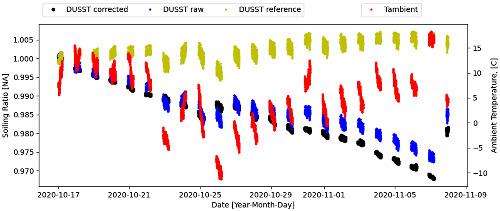当前位置:
X-MOL 学术
›
Prog. Photovoltaics
›
论文详情
Our official English website, www.x-mol.net, welcomes your
feedback! (Note: you will need to create a separate account there.)
An in-depth field validation of “DUSST”: A novel low-maintenance soiling measurement device
Progress in Photovoltaics ( IF 8.0 ) Pub Date : 2021-03-31 , DOI: 10.1002/pip.3415 Matthew Muller 1 , Leonardo Micheli 2 , Alvaro F. Solas 2 , Michael Gostein 3 , Justin Robinson 4 , Kenny Morely 4 , Michael Dooraghi 4 , Yusif A. Alghamdi 5 , Zeyad A. Almutairi 6, 7, 8 , Florencia Almonacid 2 , Eduardo F. Fernandez 2
Progress in Photovoltaics ( IF 8.0 ) Pub Date : 2021-03-31 , DOI: 10.1002/pip.3415 Matthew Muller 1 , Leonardo Micheli 2 , Alvaro F. Solas 2 , Michael Gostein 3 , Justin Robinson 4 , Kenny Morely 4 , Michael Dooraghi 4 , Yusif A. Alghamdi 5 , Zeyad A. Almutairi 6, 7, 8 , Florencia Almonacid 2 , Eduardo F. Fernandez 2
Affiliation

|
This study presents indoor and field validation results for two versions of the “DUSST” optical soiling sensor, intended to be a low-cost and low-maintenance device for measuring photovoltaic soiling losses. Indoor testing covers irradiance calibration and temperature dependencies, which are necessary to achieve high accuracy, low uncertainty field measurements. Field testing includes an array of different environments including Saudi Arabia, California, Utah, and Colorado. DUSST versions include a configuration with a 530-nm light emitting diode (LED) (discussed in previous work) and a unit with seven white LEDs and a polycarbonate collimating optic. The new design increases light intensity fivefold and demonstrates a single linear calibration coefficient is effective to measure soiling losses as high as 75%. Field data from Utah and California demonstrate that daily soiling loss measurements and soiling rate calculations closely match both reference cell and full-size module measurements of soiling losses and soiling rates. Corrective methods employed on the Utah DUSST sensor suggest that it is possible to achieve measurement errors as low as ±0.1% at two standard deviations. Field data from both Colorado and Saudi Arabia demonstrate that LED lens soiling can occur and that further design optimizations are needed. The lesson learned from all the field deployment locations suggests directions for future design improvements.
中文翻译:

“DUSST”的深入现场验证:一种新型的低维护污染测量设备
本研究展示了两种版本的“DUSST”光学污染传感器的室内和现场验证结果,旨在成为用于测量光伏污染损失的低成本和低维护设备。室内测试包括辐照度校准和温度相关性,这是实现高精度、低不确定性现场测量所必需的。现场测试包括一系列不同的环境,包括沙特阿拉伯、加利福尼亚、犹他州和科罗拉多州。DUSST 版本包括一个带有 530 纳米发光二极管 (LED)(在之前的工作中讨论过)的配置和一个带有七个白色 LED 和一个聚碳酸酯准直光学器件的单元。新设计将光强度增加了五倍,并证明单个线性校准系数可有效测量高达 75% 的污染损失。犹他州和加利福尼亚州的现场数据表明,每日污染损失测量值和污染率计算与污染损失和污染率的参考单元和全尺寸模块测量值密切匹配。犹他州 DUSST 传感器采用的校正方法表明,在两个标准偏差下可以实现低至 ±0.1% 的测量误差。来自科罗拉多州和沙特阿拉伯的现场数据表明,可能会发生 LED 透镜污染,需要进一步优化设计。从所有现场部署地点吸取的教训为未来设计改进指明了方向。犹他州 DUSST 传感器采用的校正方法表明,在两个标准偏差下可以实现低至 ±0.1% 的测量误差。来自科罗拉多州和沙特阿拉伯的现场数据表明,可能会发生 LED 透镜污染,需要进一步优化设计。从所有现场部署地点吸取的教训为未来设计改进指明了方向。犹他州 DUSST 传感器采用的校正方法表明,在两个标准偏差下可以实现低至 ±0.1% 的测量误差。来自科罗拉多州和沙特阿拉伯的现场数据表明,可能会发生 LED 透镜污染,需要进一步优化设计。从所有现场部署地点吸取的教训为未来设计改进指明了方向。
更新日期:2021-03-31
中文翻译:

“DUSST”的深入现场验证:一种新型的低维护污染测量设备
本研究展示了两种版本的“DUSST”光学污染传感器的室内和现场验证结果,旨在成为用于测量光伏污染损失的低成本和低维护设备。室内测试包括辐照度校准和温度相关性,这是实现高精度、低不确定性现场测量所必需的。现场测试包括一系列不同的环境,包括沙特阿拉伯、加利福尼亚、犹他州和科罗拉多州。DUSST 版本包括一个带有 530 纳米发光二极管 (LED)(在之前的工作中讨论过)的配置和一个带有七个白色 LED 和一个聚碳酸酯准直光学器件的单元。新设计将光强度增加了五倍,并证明单个线性校准系数可有效测量高达 75% 的污染损失。犹他州和加利福尼亚州的现场数据表明,每日污染损失测量值和污染率计算与污染损失和污染率的参考单元和全尺寸模块测量值密切匹配。犹他州 DUSST 传感器采用的校正方法表明,在两个标准偏差下可以实现低至 ±0.1% 的测量误差。来自科罗拉多州和沙特阿拉伯的现场数据表明,可能会发生 LED 透镜污染,需要进一步优化设计。从所有现场部署地点吸取的教训为未来设计改进指明了方向。犹他州 DUSST 传感器采用的校正方法表明,在两个标准偏差下可以实现低至 ±0.1% 的测量误差。来自科罗拉多州和沙特阿拉伯的现场数据表明,可能会发生 LED 透镜污染,需要进一步优化设计。从所有现场部署地点吸取的教训为未来设计改进指明了方向。犹他州 DUSST 传感器采用的校正方法表明,在两个标准偏差下可以实现低至 ±0.1% 的测量误差。来自科罗拉多州和沙特阿拉伯的现场数据表明,可能会发生 LED 透镜污染,需要进一步优化设计。从所有现场部署地点吸取的教训为未来设计改进指明了方向。











































 京公网安备 11010802027423号
京公网安备 11010802027423号